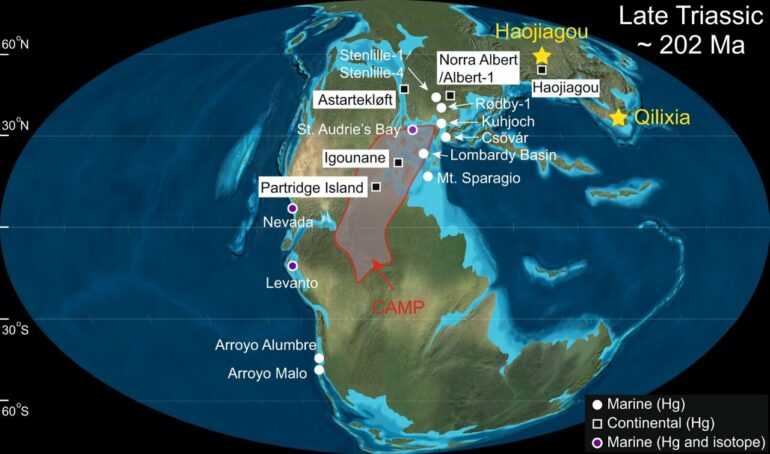The Triassic-Jurassic transition (~ 201 Ma) saw one of the most catastrophic volcanic eruptions during the Phanerozoic, namely the Central Atlantic Magmatic Province (CAMP), and it has been suggested to have triggered a series of environmental/climatic perturbations which eventually caused the end-Triassic mass extinction.However, due to the lack of volcanic ash sediments outside its eruption sites, the spatial extent of the impact is not well understood.
Recently, researchers from China University of Geosciences (Wuhan), Nanjing Institute of Geology and Palaeontology of the Chinese Academy of Sciences (NIGPAS), in collaboration with researchers from the U.S., have reported elevated Hg concentrations and isotopes from terrestrial sediments of two sites in the Junggar Basin and the Sichuan Basin in China.
This study was published in Nature Communications on Jan. 13.
These two sites are spatially distant from the CAMP, but the finding can be considered direct evidence of intense volcanism in association with CAMP.
The researchers also reported pronounced elemental and clay mineralogical changes at the same level as the elevated Hg concentrations and interpreted them as signs of enhanced weathering intensity of sediment sources.
“Our findings show a direct linkage between intensified volcanism and immediate weathering response outside the CAMP sites during that critical time interval in Earth history,” said Prof. Wang Yongdong, co-corresponding author of the study.
With the help of previous time frameworks established by astronomical cycles, the researchers found that the impact of volcanism on weathering has lasted for ~ 2 million years, which is consistent with their modeling results.
Chemical weathering of rocks on land may have been an important method the Earth adopted to draw down excess CO2 in the atmosphere in order to maintain relatively stable climatic conditions in the Earth surface ecosystems.
These two study sites occupied a high and a low paleolatitudes, respectively. By comparing the amplitude of the enhancement of chemical weathering conditions, the researchers concluded that the chemical weathering was more pronounced in the higher latitudes than in the lower latitudes during the eruption of the CAMP.
More information:
Jun Shen et al, Intensified continental chemical weathering and carbon-cycle perturbations linked to volcanism during the Triassic–Jurassic transition, Nature Communications (2022). DOI: 10.1038/s41467-022-27965-x
Provided by
Chinese Academy of Sciences
Citation:
Direct linkage between intensified volcanism and immediate weathering (2022, January 19)



